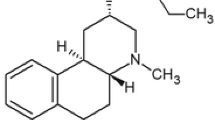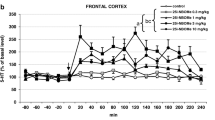Abstract
The 5-HT1A agonists buspirone, gepirone and ipsapirone have been shown to possess antidepressive-like properties in several animal models of depression as well as in clinical studies. These compounds are metabolized to 1-(2-pyrimidinyl)-piperazine (1-PP) in rats and humans. In the learned helplessness paradigm, buspirone exhibits a biphasic action: at low or moderate doses it shows an antidepressant-like effect but this action progressively disappears as the doses are increased. In order to establish whether 1-PP affects the reversal of helpless behaviour induced by the 5-HT1A agonists at high doses in rats, we have investigated its role in the learned helplessness. Thus, 1-PP has been evaluated alone (0.06-4 mg/kg/day) or in combination with a selective 5-HT1A agonist 8-OH-DPAT (0.25 mg/kg/day) which is not metabolized to 1-PP and buspirone (0.5 mg/kg/day). In addition, buspirone at a higher dose (2 mg/kg/day) has also been examined in the presence of proadifen which inhibits oxidative metabolism. Our results show that i) daily injections of 1-PP did not reverse helpless behaviour, ii) the reversal of helpless behaviour by 8-OH-DPAT or active dose of buspirone was antagonized by daily coadministration of 1-PP, iii) in rats pretreated with proadifen, the highest “inactive” dose of buspirone induces a reversal of helpless behaviour. These results strongly suggest that up to a certain concentration 1-PP can impair the effects of the parent drug in the learned helplessness.
Similar content being viewed by others
References
Caccia S, Fong MH, Guiso G (1985) Disposition of the psychotropic drugs buspirone, MJ-13805 and piribedil, and of their common active metabolite 1-(2-pyrimidinyl)piperazine in the rat. Xenobiotica 15:835–844
Caccia S, Conti I, Vigano G, Garattini S (1986) 1-(2-pyrimidinyl) piperazine as an active metabolite of buspirone in man and rat. Pharmacology 33:46–51
Cervo L, Samanin R (1987) Potential antidepressant properties of 8-hydroxy-2-(di-n-propylamino)tetralin, a selective serotonin1A receptor agonist. Eur J Pharmacol 144:233–229
Cervo L, Grignaschi G, Samanin R (1988) Different effects of intracerebral and systemic administrations of buspirone in the forced swimming test: involvement of a metabolite. Life Sci 43:2095–2102
Engberg G (1989) A metabolite of buspirone increases locus coeruleus activity via alpha2-receptor blockade. J Neural Transm 76:91–98
Gammans RE, Mayol RF, Eison MS (1983) Concentration of buspirone and 1-pyrimidinyl-piperazine, a metabolite, in rat brain. Fed Proc 42:377
Giral Ph, Martin P, Soubrié Ph, Simon P (1988) Reversal of helpless behaviour in rats by putative 5-HT1A agonists. Biol Psychiatry 23:237–242
Gower AJ, Tricklebank MD (1988) Alpha2-adrenoceptor antagonist activity may account for the effects of buspirone in an anticonflict test in the rat. Eur J Pharmacol 155:129–137
Graeff EO, Hunziker MHL, Graeff FG (1989) Effects of ipsapirone and BAY R 1531 on learned helplessness. Braz J Med Biol Res 22:1141–1144
Jajoo HK, Mayol RF, Labudde JA, Blair IA (1989) Metabolism of the antianxiety drug buspirone in the rat. Drug Metab Dispos 17:625–633
Martin P, Soubrié P, Simon P (1986) Shuttle-box deficits induced by inescapable shocks in rats: reversal by the beta-adrenoceptor stimulants clenbuterol and salbutamol. Pharmacol Biochem Behav 24:177–181
Martin P, Beninger RJ, Hamon M, Puech AJ (1990) Antidepressant-like action of 8-OH-DPAT, a 5-HT1A agonist in the learned helplessness paradigm: evidence for a postsynaptic mechanism. Behav Brain Res 35:135–144
Perrault G, Morel E, Claustre Y, Sanger DJ, Zivkovic B (1989) Involvement of dopaminergic mechanism in the antidepressant-like effect of 8-OH-DPAT in the forced swimming test in mice. J Psychopharmacol 3:69P
Przegalinski E, Tatarczynska E, Chojnacka-Wojcik E (1990) Antidepressant-like activity of ipsapirone, buspirone and gepirone in the forced swimming test in rats pretreated with proadifen. XIth International Congress of Pharmacology. Eur J Pharmacol 183:1906
Rimele TJ, Henry DE, Lee DKH, Geiger G, Heaslip RJ, Grimes D (1987) Tissue-dependent alpha-adrenoceptor activity of buspirone and related compounds. J Pharmacol Exp Ther 241:771–778
Robinson DS, Alms DR, Shrotriya RC, Messina ME, Wickramaratre P (1989) Serotonergic anxiolytics and treatment of depression. Psychopathology 22[suppl 1]:22–36
Schreiber R, De Vry (1990) Neuro-anatomical correlated of the anxiolytic effects of the 5-HT1A receptor ligands 8-OH-DPAT, ipsapirone and buspirone in the rat. 3rd meeting of the European Behavioural Pharmacology Society. Psychopharmacology 101 [suppl]:S52
Sherman AD, Sacquitine JL, Petty F (1982) Specificity of the learned helplessness model of depression. Pharmacol Biochem Behav 16:449–454
Tatarczynska A, Chojnacka-Wojcik E (1989) Effects of 8-OH-DPAT and ipsapirone in the tests used for evaluation of the antidepressant action. Pol J Pharmacol Pharm 41:321–330
Weiss JM, Simson PG, Ambrose MJ, Webster A, Hoffman LJ (1985) Neurochemical basis of behavioral depression. In: Katkin E, Manuck S (eds) Advances in behavioral medicine. JAI Press, Greenwich, Connecticut, pp 233–275
Author information
Authors and Affiliations
Rights and permissions
About this article
Cite this article
Martin, P. 1-(2-Pyrimidinyl)-piperazine may alter the effects of the 5-HT1A agonists in the learned helplessness paradigm in rats. Psychopharmacology 104, 275–278 (1991). https://doi.org/10.1007/BF02244191
Received:
Revised:
Issue Date:
DOI: https://doi.org/10.1007/BF02244191




